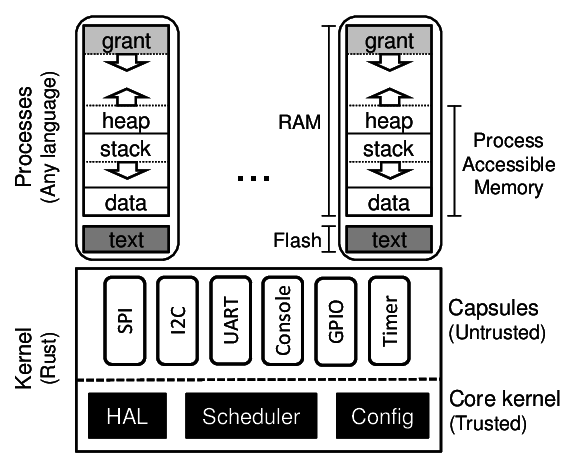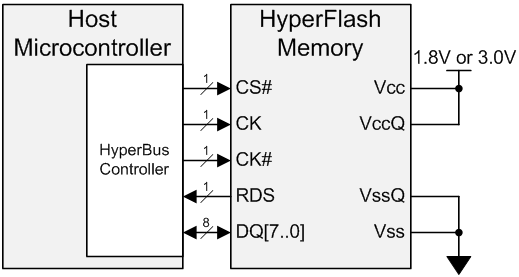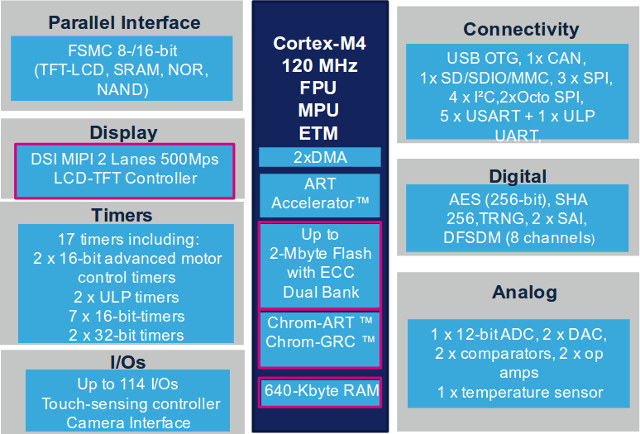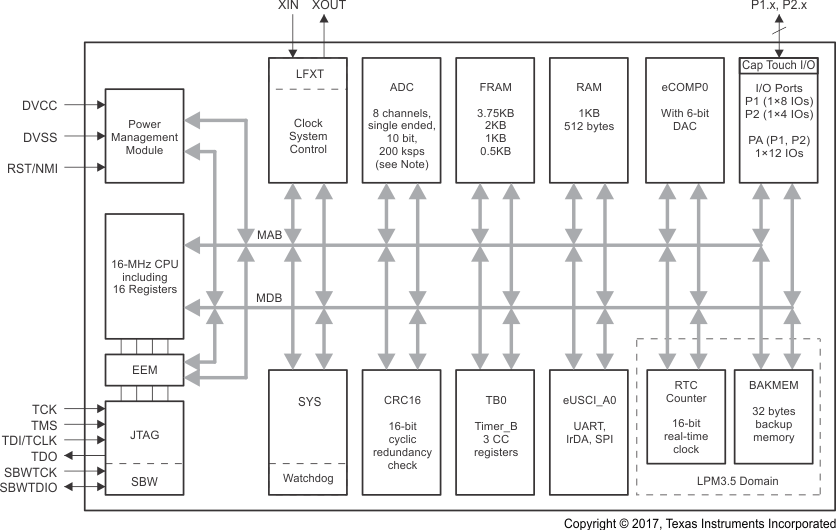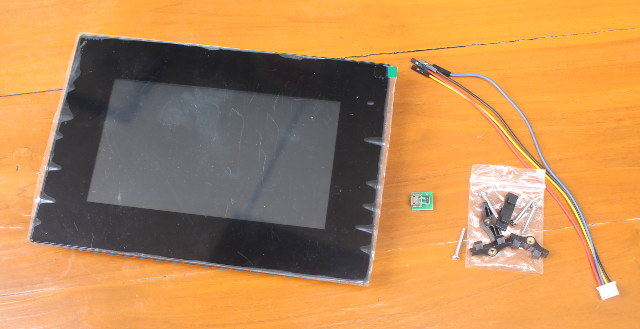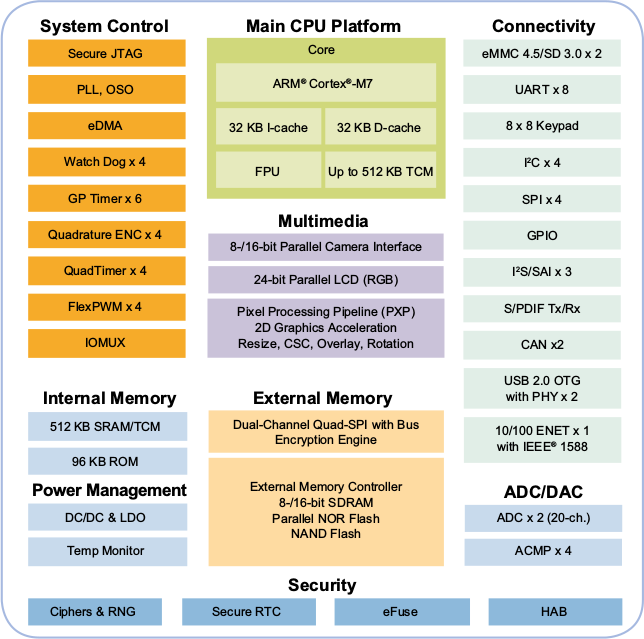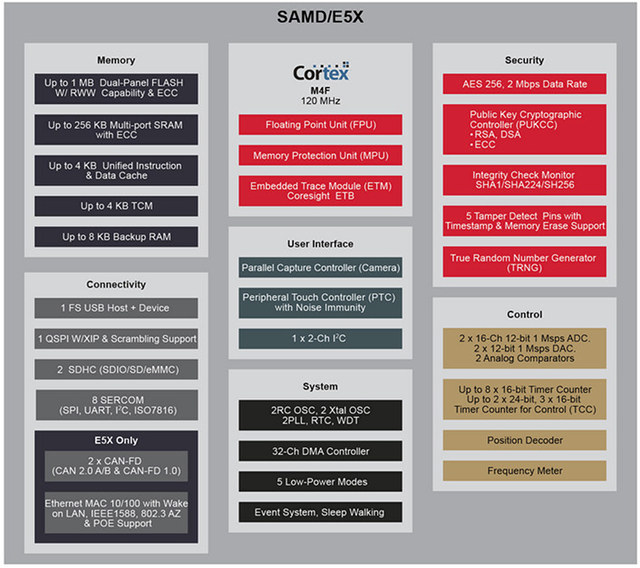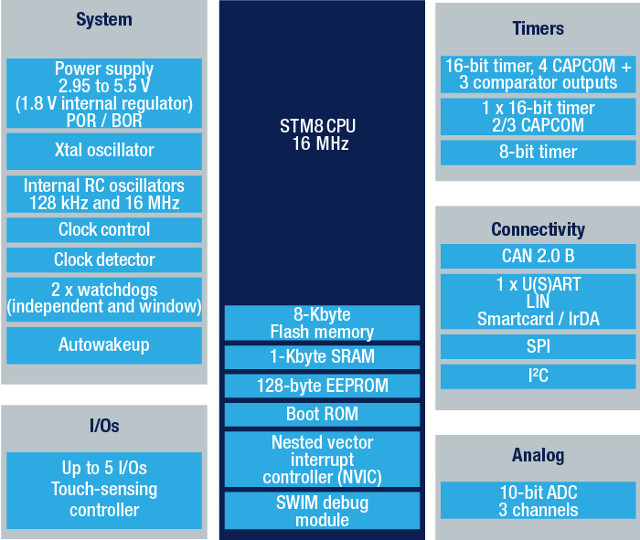We already have a fair share of open source operating systems running on Arm Cortex-M microcontrollers with FreeRTOS, mbed OS, Zephyr OS, RIOT, and many others. Earlier this morning, as I wrote about the Embedded Linux and IoT Summit 2018, I discovered you can now also add Tock to the list, with the operating system specifically designed for (secure) IoT on Arm Cortex-M MCUs. According to the abstract, Tock aims to enable more secure and extensible IoT systems by using a language sandbox and hardware enforced mechanism to isolate third-party and other untrusted code in the system. The operating systems is comprised of three components: A trusted core kernel written in Rust language with a HAL, scheduler and platform-specific configuration Capsules compiled with the kernel and use Rust’s type and module systems for safety; typically used for drivers & virtualization layers User-space processes using the MPU for hardware protection at runtime; […]
Octo SPI / HyperBus Interface is Designed for High Speed Serial Flash, RAM, and MCP
So far, if you needed high speed storage with low pin count in your MCU based board, you could use QSPI (Quad SPI) NOR flash, but earlier this month I wrote about STM32L4+ MCU family, which added two Octo SPI interfaces. I had never heard about Octo SPI previously. Those two interfaces can be used with single, dual, quad, or octal SPI compatible serial flash or RAM, and support a frequency of up to 86 MHz for Octal SPI memories in STM32L4+ MCU. STMicro OctoSPI interface also supports Cypress/Spansion Hyperbus mode to connect to HyperFlash or HyperRAM chip, or even HyperFlash + HyperRAM Multi-Chip packages (MCP), and variable or fixed external memory latency as defined by the Hyperbus protocol specification. The latter reveals Hyperbus supports performance up to 400 MB/s (provided the controller support 200 MHz), and relies on either 11 bus signals using 3.0V I/O (Single-ended clock CK), or […]
STMicro Introduces Ultra-efficient STM32L4+ Series MCUs with Better Performance, Chrom-GRC Graphics Controller
STMicroelectronics has announced an upgrade to their STM32L4 series Cortex-M4 micro-controllers with STM32L4+ series upping the maximum frequency from 80 MHz to 120 MHz delivering up to 150 DMIPS (233 ULPMark-CP) , and ultra low power consumption as long as 33 nA in shutdown mode without RTC. The new family also adds Chrom-GRC graphics controller (GFXMMU) that can handle both circular and square TFT LCD displays together with a MIPI DSI interface and displayer controller, making it ideal for wearables, Chrom-ART 2D accelerator for better graphics performance, two Octo SPI interfaces, and more memory (640KB max) and storage (up to 2MB flash). If you want to know all differences between STM32L4 and STM32L4+, and/or learn how to use peripherals, STMicro has setup a nice free STM32L4+ online training page, which allow you to do just that either by downloading PDF documents, or following e-Presentations with slides and audio. STM32L4+ appears […]
Texas Instruments MSP430 Value Line Sensing MCUs Sell for 25 Cents and Up
Texas Instruments MSP430 16-bit mixed signal microcontroller has been around since at least 2004, and the last time I played with the MCU was with eZ430-Chronos wireless watch development kit in 2011. Over the years, the company has added more parts to its MSP430 MCU portfolio, and they recently added two new MSP430 Value Line Sensing MCUs that offer up to 25 functions (timers, I/Os, reset controller, EEPROM…) for as low as 25 cents, as well as a new MSP430FR2433 LaunchPad development kit . MSP430FR2000 and MSP430FR2100 MCUs have the same features set, except for the memory (512 vs 1024 bytes): 16-Bit RISC Architecture up to 16 MHz Memory / Storage MSP430FR2000 (new) – 0.5KB of Program Ferroelectric RAM (FRAM) + 512 Bytes of RAM MSP430FR2100 (new) – 1KB of Program FRAM + 512 Bytes of RAM MSP430FR2111 – 3.75KB of Program FRAM + 1KB of RAM MSP430FR2110 – 2KB of Program FRAM + 1KB of RAM Supply Voltage […]
Giveaway Week – Nextion Enhanced 7″ Capacitive Display
My Nextion Enhanced NX8048K070 display will soon find a new home. The 7″ display comes with a capacitive touchscreen, an enclosure, and can work in standalone mode thanks to a built-in processor and a 8-pin FPC connector for I/Os, or connected to a micro-controller through a UART interface. I did a mini review of the display, mostly showing a teardown, and how to use Nextion Display Editor Windows-only tool to design your own user interface. The GPIOs are not really convenient to use with the required flat cable, and the company did not send me their $5 IO board, which would have made things easier. Learning curve may be a little sharper than needed as I’ve not found the Windows software to be very user-friendly, and documentation could be improved too. I’ll give the display with enclosure, micro USB power board, and UART cable as shown on the first photo. […]
NXP i.MX RT Series Crossover Embedded Processor is Based on an ARM Cortex-M7 Core @ 600 MHz
Microcontrollers (MCUs) provide real-time processing, low power, low cost, and plenty of I/Os, but with security and user interface requirements of recent embedded devices, the processing power may be a limitation, and embedded systems designers may have to use an application processor instead gaining performance, but losing some of the benefits of MCUs. The bridge the gap between performance and usability, NXP has launched i.MX RT series of Crossover Embedded Processor which uses the powerful ARM Cortex-M7 MCU core clocked at up to 600 MHz, a frequency partially made possible by eliminating on-chip flash memory. The first member of the family is NXP i.MX RT1050 with the following key features and specifications: MCU Core – ARM Cortex-M7 @ up to 600 MHz; 3015 CoreMark / 1284 DMIPS Memory – Up to 512KB SRAM/TCM (Tighly Coupled Memory) with response time as low as 20 ns Storage – 96KB RAM; interfaces: NAND, […]
Microchip SAM D5x and SAM E5x ARM Cortex-M4 Micro-Controllers Launched with Optional Ethernet and CAN Bus
Microchip has just introduced two new families of micro-controllers based on ARM Cortex-M4F with SAM D5x and SAM E5x series sporting up to 1 MB of dual-panel flash and 256 KB of SRAM both with ECC support. Both families also support QSPI flash with XIP (eXecute In Place) support, features an SD card controller and a capacitive touch controller, with SAM E5x family also adding support for two CAN-FD ports and Ethernet. Microchip SAM A5x/E5x key features and specifications: MCU Core – ARM Cortex-M4F core running at 120 MHz with single precision Floating Point Unit (FPU) Memory – Internal memory architecture with user configurable Tightly Coupled Memory, System memory, Memory Protection Unit and 4KB Combined I-cache and D-cache; up to 256KB ECC SRAM, up to 1MB ECC flash Storage I/F – Quad Serial Peripheral Interface(QSPI) with Execute in Place (XIP) Support Peripherals Up to 2x Secure Digital Host Controller (SDHC) […]
STMicro Introduces 20 Cents STM8S001J3 8-Bit MCU in 8-Pin Package
STMicro has launched a new 8-bit micro-controller that sells for $0.20 per unit in 10k quantities, a price not too far from the one of cheapest MCU, especially considering it comes with flash. STM8S001J3 is also the first STM8 MCU offered in 8-pin package (SO8N), and should compete with some of the Microchip Attiny or PIC12F series micro-controllers. STM8S001J3 specifications: Core – 16 MHz advanced STM8 core with Harvard architecture and 3-stage pipeline,extended instruction set System Memory – 1 Kbyte RAM Storage 8 Kbytes Flash memory; data retention 20 years at 55 °C after 100 cycles 128-byte true data EEPROM; endurance up to 100 k write/erase cycles Clock, reset and supply management 2.95 V to 5.5 V operating voltage Flexible clock control, 3 master clock sources: external clock input; internal, user-trimmable 16 MHz RC; internal low-power 128 kHz RC Clock security system with clock monitor Power management – Low-power modes […]


